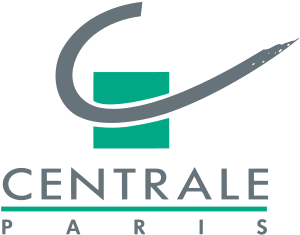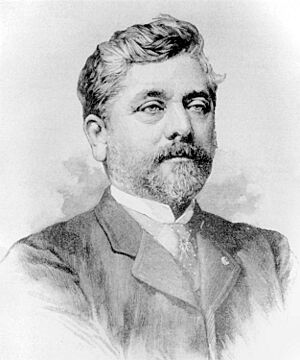École Centrale Paris facts for kids
 |
|
| Motto | Leader, Entrepreneur, Innovateur |
|---|---|
| Type | Public, Grand établissement |
| Active | 1829–2015 |
| President | Hervé Biausser |
| Postgraduates | 2,505 (1,789 engineer candidates) |
| 223 | |
| Location |
,
France
|
| Affiliations | University of Paris-Saclay, Centrale Graduate School, TIME, CESAER, UniverSud Paris |
École Centrale Paris (also known as ECP or Centrale) was a famous French engineering and science school. It was officially called École Centrale des Arts et Manufactures. In 2015, École Centrale Paris joined with Supélec to create CentraleSupélec. This new school is now part of the University of Paris-Saclay.
Founded in 1829, École Centrale Paris was one of the most respected and difficult schools to get into in France. It had a long history of training top engineers and business leaders. Many leaders in French industry came from this school. Since the 1800s, its way of teaching engineers inspired other schools around the world. These include schools in Switzerland, Belgium, and other countries like Morocco, China, and India.
Contents
History of the School
"Between 1832 and 1870, the Central School of Arts and Manufactures trained 3,000 engineers. It became a model for many industrial countries."
École Centrale des Arts et Manufactures started in 1829. It was a private school founded by Alphonse Lavallée, a lawyer and businessman. He used most of his own money to start the school. Three important scientists helped him: Eugène Peclet, Jean-Baptiste Dumas, and Théodore Olivier.
The main idea behind École Centrale was to train engineers who knew many different subjects. They were meant to be the first "doctors of factories and mills." This was important because France's industrial world was growing fast. Most other engineering schools at the time trained students for government jobs. New discoveries in science were changing industries in Europe. France needed engineers with strong knowledge in science and math to grow its own industries. This would help France compete with other powerful countries.
The school was first located in different buildings in Paris. These included Hotel Salé, which is now the Picasso Museum. Lavallée was the first president of the school.
In 1857, Lavallée gave the school to the French government. This made sure the school would continue to exist. For a short time, it was called École Impériale des Arts et Manufactures.
In 1862, students who finished the school received official engineering degrees. This was the first time such a degree, called 'ingénieur des arts et manufactures', was given in France.
In 1969, the school moved to a new campus in Châtenay-Malabry. President Georges Pompidou opened the new campus. The school was then renamed École Centrale des Arts et Manufactures.
In 2015, the school joined with Supélec to form CentraleSupélec. This new school is part of the University of Paris-Saclay. The new main campus is in Gif-sur-Yvette, about 20 kilometers from Paris.
Working with Other Schools
École Centrale Paris was part of the Centrale Graduate Schools network. This group, called the Groupe Centrale, included sister schools in other cities. These were in Lille, Lyon, Marseille, Nantes, Beijing, Hyderabad (India), and Casablanca (Morocco).
Since 1837, the school worked with many top universities around the world. They had programs for double degrees, student exchanges, and research. Some of these universities included California Institute of Technology, University of Cambridge, ETH Zurich, Georgia Institute of Technology, Harvard University, Massachusetts Institute of Technology, and Stanford University. It was also a founding member of the TIME network. This network connects top engineering schools in Europe.
School Locations
The school was first located in the Hôtel de Juigné in Paris. Then, in 1884, its main campus moved to rue Montgolfier. It stayed there until 1969. Its last location was in Châtenay-Malabry, near the Parc de Sceaux.
Here are some pictures of the former location of the École Centrale on rue Montgolfier in Paris:
At the Châtenay-Malabry campus, ECP had eight research laboratories. These labs studied topics like energy, engineering, and mathematics. Most of the 2000 students at École Centrale Paris lived in student housing on campus. These homes were close to the research labs and easy to reach by public transport.
After the school joined with Supelec to form CentraleSupelec, the campus started moving. It is now moving from Chatenay-Malabry to Gif-sur-Yvette.
How to Get Admitted
Most French students who got into École Centrale Paris had first completed special classes. These were called classes préparatoires or prépas. These classes usually lasted 2 to 3 years after high school. They are like the first two years of university in the US. The classes préparatoires program itself is very selective. Less than 10% of high school graduates in France get into it each year. Students took the entrance exam for grandes écoles like École Centrale Paris after their second year in prépas.
For its main engineering degree, École Centrale Paris accepted only the top 4% of students from prépas in 2016. This was for about 400 students. They also accepted about 50 international students from top universities. These international students went through a similarly tough selection process.
International students were first chosen by their home universities. They had to have excellent grades. They also got extra training in subjects like math, science, and French. Then, they applied and competed for a spot at the school. This involved written and oral exams. Their application also needed letters from professors, a list of their achievements outside of school, and a letter explaining why they wanted to join.
Finally, a small number of spots were saved for French university graduates. These were students who did very well in a 3-year bachelor's degree program.
What Students Studied
The general engineering program at Centrale taught many different subjects. It usually lasted between 3 and 4 years. The courses were similar to those at other general engineering schools. All classes were taught in either French or English.
In the first year, called Tronc Commun (Common Core), students studied many subjects. These included science (like math and physics), engineering (like mechanics and programming), and social sciences (like economics and languages). In the second year, students could choose some elective courses. However, there was still a strong focus on science. The first two years also included projects in research, startups, and industry.
In the third year, students could choose to specialize in a certain area. This depended on what they were interested in for their studies and future jobs. After graduating, students received the Diplôme d'Ingénieur degree. This is similar to a Master of Science degree. They also got the title of Ingénieur diplômé, often called Ingénieur centralien.
Advanced Studies
The school offered many specialized master's programs in science and engineering. These programs lasted one or two years.
It also had different PhD programs for students who already had a master's degree. More than 200 students working on their PhDs were in the school's eight laboratories.
Famous Graduates

Many famous people graduated from École Centrale Paris. They are often called Centraliens or Pistons. This name refers to the piston engine, which was a key invention during the French Industrial Revolution.
Here are some notable graduates:
- Norbert Rillieux (1830), invented a machine that made sugar production easier.
- Gustave Eiffel (1855), designed the Eiffel Tower and the inside structure of the Statue of Liberty.
- William Le Baron Jenney (1856), designed the first building with a steel frame in Chicago.
- Georges Leclanché (1860), invented a type of battery called the Leclanché cell.
- Émile Levassor and René Panhard (1864), started the first car manufacturing company, Panhard et Levassor.
- André Michelin (1877), founded the Michelin tire company.
- Louis Blériot (1895), a flying pioneer, was the first pilot to fly across the English Channel.
- Armand Peugeot (1895), founded the car company Peugeot (Peugeot PSA).
- Pierre-Georges Latécoère (1906), a flying pioneer, founded Latécoère and Aéropostale (which later became Air France).
- Marcel Schlumberger (1907), co-founded Schlumberger Limited, a big oilfield services company.
- Boris Vian (1942), a famous writer.
- Francis Bouygues (1947), founded Bouygues, a large construction company.
- Gérard Pélisson (1955), founded the Accor group, which owns many hotels like Novotel and Sofitel.
- Antoine (1966), a singer-songwriter and navigator.
- Henri Gouraud (1967), a computer scientist.
- Benoît Potier (1979), CEO of Air Liquide, a company that makes industrial gases.
- Carlos Tavares (1981), former CEO of Stellantis, a major car company.
- Bernard Liautaud (1984), founder of Business Objects.
- Édouard Michelin (born 1963) (1987), former CEO of Michelin.
- Stephane Bancel (1995), CEO of Moderna, a biotechnology company.
- Olivier Pomel (1999), Founder and CEO of Datadog, a software company.
- Jean-Baptiste Kempf (2006), Creator of VLC media player.
Important Teachers
Many important scientists and thinkers taught at École Centrale Paris. Here are a few:
- Paul Appell – a mathematician.
- Raymond Barre – an economist and former French prime minister.
- Sébastien Candel – a physicist and Vice President of the French Academy of Sciences.
- Gustave-Gaspard Coriolis – a physicist, known for the Coriolis effect (which explains how moving objects are affected by Earth's rotation).
- Jean-Baptiste Dumas – a chemist, known for his work on atomic weights.
- Jacques Hadamard – a mathematician.
- Étienne Klein – a physicist and philosopher of science.
- Joseph Liouville – a mathematician.
- Anselme Payen – a chemist, who discovered the first enzyme.
- Eugène Péclet – a physicist, known for the Péclet number (used in heat transfer).
See also
 In Spanish: École centrale Paris para niños
In Spanish: École centrale Paris para niños
- Education in France





